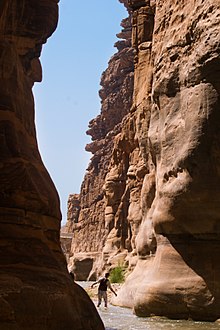King's Road (Jordan)
The King's Road is a historic trade route from northern Syria to the Red Sea . The high path was formed about 4000 years ago. "This caravan route, which bypasses Palestine to the east, has always been preferred to the route through the Jordan Valley ." The modern traveler who drives on the R 35 from Amman via Madaba and Kerak towards Petra also follows this historic trade route.
Literary testimony
The Mescha stele mentions the expansion of the King's Road as one of the achievements of the King of Moab : "I built Aroër, I created the road on the Arnon ." The King's Road was a lifeline of the Moab Empire. “A caravanserai, which was uncovered near Khirbet Arair and measures 50 × 50 meters, can be assigned to this period.” The fortification of this section of the road was strategically important because the steeply sloping Wadi Mujib formed a natural border. The heartland of Moab was south of the wadi, but for a long time the kings of Moab ruled areas further north as far as Madaba . Two forts at this point date from the Nabatean and Roman times.
The name "King's Road" is not explained in the Bible ( Numbers 20, 17 and 21, 22), but assumed to be generally known. The Israelites are on their way to the promised land, the use of the King's Road from Edom itern and denied Amorites. Here you learn that the road led through fertile land: there were fields, vineyards and wells. That made them stand out from a parallel route through the desert about 30 km further east, which was shorter but more dangerous.
Herodotus mentions a royal road as a connection between the Persian Empire and the Mediterranean; the caravan route through present-day Jordan was a southern branch of this great trade route.
Expansion to Via Traiana Nova
From 111 to 114 AD, Emperor Trajan had the 430 km long route, until then only a path cleared of rubble, expanded into a Roman road (Via Traiana Nova). It connected Damascus and Bosra , the cities of the Decapolis ( Scythopolis , Pella, Gerasa , Philadelphia ), the Nabatean city of Petra and the Gulf of Aqaba . The new trunk road facilitated the exchange of goods between Syria and Palestine and the new Roman province of Arabia .
literature
- Fawzi Zayadine: The King's Road . In: World and Environment of the Bible 1/1998, p. 35.
- Pierre Amiet: The royal road . In: Siegfried Mittmann et al. (Ed.): The Royal Route. 9000 years of art and culture in Jordan , Philipp von Zabern, 1987, ISBN 3-8053-0960-0 , pp. 15-25.
- Dirk Kinet: Jordan . Kohlhammer, Stuttgart 1992, ISBN 3-17-010807-7
- Andreas Feldtkeller : Jordan . EVA Leipzig 2007, ISBN 978-3-374-02462-9 , pp. 88-111.
Individual evidence
- ↑ a b c Pierre Amiet: The Royal Route . S. 15 .
- ^ Andreas Feldtkeller: Jordan . S. 104 .
- ^ Andreas Feldtkeller: Jordan . S. 105 .
- ↑ Dirk Kinet: Jordan . S. 172 .
- ↑ Ulrike Sals: Numbers . In: Explained - the commentary on the Zurich Bible . tape 1 . TVZ, Zurich 2010, ISBN 978-3-290-17425-5 , p. 364 : “With this text begins a series of diplomatic and military encounters with other peoples. ... Edom is another name for Esau. ... If Jacob had feared his anger on his return to his brother and was still positively surprised (Gen. 33, 1-16), here the extremely peaceful desire of Jacob's descendants meets Edom's aggressive responses. "
- ^ Andreas Feldtkeller: Jordan . S. 89 (This parallel route roughly corresponds to today's desert highway.).

